

Learning OpenCV. "This library is useful for practitioners, and is an excellent tool for those entering the field: it is a set of computer vision algorithms that work as advertised.
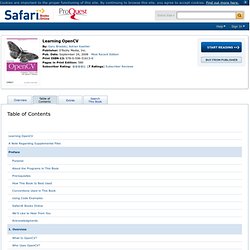
" -William T. Freeman, Computer Science and Artificial Intelligence Laboratory, Massachusetts Institute of Technology Learning OpenCV puts you in the middle of the rapidly expanding field of computer vision. Written by the creators of the free open source OpenCV library, this book introduces you to computer vision and demonstrates how you can quickly build applications that enable computers to "see" and make decisions based on that data. Computer vision is everywhere-in security systems, manufacturing inspection systems, medical image analysis, Unmanned Aerial Vehicles, and more. The Serious Computer Vision Blog. By Gooly (Li Yang Ku) If you remember, I talked about how the image search app Amazon Flow might work last year, and promised I would talk about Google Goggle later, which I didn’t (and I blame my unpredictable life and laziness).

To compensate that I am gonna talk about a similar app, but before downloading the app please read the whole post for your own sake. The app I am gonna discuss today is CamFind. Someone recommended the app on Facebook so I decided to give it a try. OpenCV: Image Processing and Computer Vision Reference Manual. .
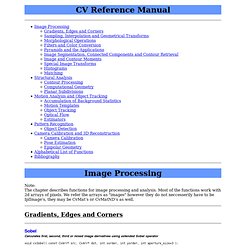
There may be more than one connected component per a cluster. The images src and dst should be 8-bit single-channel or 3-channel images or equal size PyrMeanShiftFiltering Does meanshift image segmentation. Extending the hand tracker with snakes and optimizations [w/ code, OpenCV] I wish to report of a number of tweaks and additions to the hand silhouette tracker I posted a while back.
![Extending the hand tracker with snakes and optimizations [w/ code, OpenCV]](http://cdn.pearltrees.com/s/pic/th/extending-optimizations-69059678)
First is the ability for it to "snap" to the object using a simple Active Snake method, another is a more advanced resampling technique (the older tracker always resampled after every frame), and of a number of optimizations to increase the speed (tracker now runs at real-time on a single core). Guided Resampling In the last implementation of the hand tracker the particles were re-sampled in every iteration. Resampling means that after evaluating the fitness for each hypothesized particle to the measurement an implicit distribution function is created, and from that distribution new particles are drawn. Opencv. Dec 18 2013 Simple NURBS renderer [w/ code] Simple NURBS renderer, reading from a DXF May 26 2013.
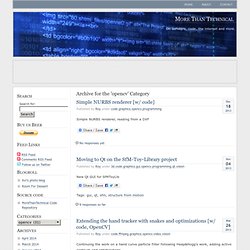
Eric Yuan's Blog. Convolutional Neural Networks II Since the last CNN post, I was working on a new version of CNN, which support multi-layers Conv and Pooling process, I’d like to share some experience here.
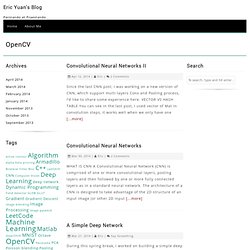
VECTOR VS HASH TABLE You can see in the last post, I used vector of Mat in convolution steps, it works well when we only have one [...more] Source code for SIFT, ORB, FAST and FFME for OpenCV C++ for egomotion estimation. Hi everybody!
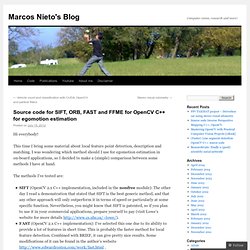
This time I bring some material about local feature point detection, description and matching. I was wondering which method should I use for egomotion estimation in on-board applications, so I decided to make a (simple) comparison between some methods I have at hand. The methods I’ve tested are: SIFT (OpenCV 2.x C++ implementation, included in the nonfree module): The other day I read a demonstration that stated that SIFT is the best generic method, and that any other approach will only outperform it in terms of speed or particularly at some specific function. Nevertheless, you might know that SIFT is patented, so if you plan to use it in your commercial applications, prepare yourself to pay (visit Lowe’s website for more details (OpenCV 2.x C++ implementation): I’ve selected this one due to its ability to provide a lot of features in short time.
Félix Abecassis. In a previous article I presented how to compute the skew angle of a digitized text document by using the Probabilistic Hough Transform.
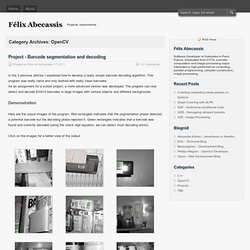
In this article we will present another method in order to calculate this angle , this method is less acurate than the previous one but our goal is rather to introduce two new OpenCV techniques: image scan with an iterator and computing the minimum bounding box of a set of points. Bounding Box The minimum bounding box of a set of 2D points set is the smallest rectangle (i.e. with smallest area) that contains all the points of the set. Given an image representing a text, like this one: OpenCV Code. OpenCVHandGuesture/main.cpp at master · jujojujo2003/OpenCVHandGuesture. Hand Tracking And Gesture Detection (OpenCV) The aim of the project was to device a program that is able to detect out hands, track them in realtime and perform some guesture recognition.
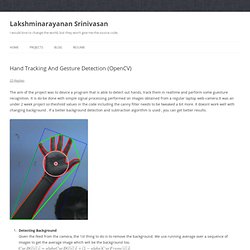
It is do be done with simple signal processing performed on images obtained from a regular laptop web-camera.It was an under 2 week project so theshold values in the code including the canny filter needs to be tweaked a bit more. It doesnt work well with changing background . If a better background detection and subtraction algorithm is used , you can get better results.
Detecting Background Given the feed from the camera, the 1st thing to do is to remove the background. We use running average over a sequence of images to get the average image which will be the background too. Simple Kalman filter for tracking using OpenCV 2.2 [w/ code] Jun 17 2011. OpenCV Tutorial 9. Author: Noah Kuntz (2009)Contact: nk752@drexel.edu Keywords: OpenCV, computer vision, image processing, optic flow, tracking, motion My Vision Tutorials Index This tutorial assumes the reader: (1) Has a basic knowledge of Visual C++ (2) Has some familiarity with computer vision concepts (3) Has read the previous tutorials in this series The rest of the tutorial is presented as follows: Important Note!

/trunk/opencv/samples – OpenCV. Context Navigation. Tutorials — OpenCV 2.4.6. The following links describe a set of basic OpenCV tutorials. All the source code mentioned here is provide as part of the OpenCV regular releases, so check before you start copy & pasting the code. The list of tutorials below is automatically generated from reST files located in our GIT repository.
OpenCV Tutorials and Source-Code by Shervin Emami. Last updated on 3rd October, 2010 by Shervin Emami. Posted originally on 2nd June, 2010. OpenCV is a great library for creating Computer Vision software using state-of-the-art techniques, and is freely available for Windows, Linux, Mac and even Android & iPhone. OpenCV was originally designed by Intel in 1999 to show how fast Intel CPUs can run. OpenCV, Computer Vision and Robotics Tutorials at AI Shack. Installing & Configuring with Visual Studio. In this tutorial, I am using OpenCV 2.4.5 and Visual Studio 2012. But it is almost same for other versions of OpenCV and Visual Studio. If you want, you can refer to the older post Installing & Configuring OpenCV2.1 with Visual Studio 2010. There are 2 ways to install OpenCV into your computer. But for a beginner, the most suitable way is the installation by using the pre-built libraries. So, I am going to discuss how to install OpenCV by using pre-built libraries.
ChangeLog - OpenCV DevZone. WikiStart » April, 2014. Median Filter using C++ and OpenCV: Image Processing. Basic Theory Median filter also reduces the noise in image like low pass filter, but it is better than low pass filter in the sense that it preserves the edges and other details. Oen_CV 2.4.6.0 documentation. FileStorage. File Input and Output using XML and YAML files — OpenCV 2.4.6.0 documentation. Goal. Mat. Mat - The Basic Image Container — OpenCV 2.4.6.0 documentation. Goal We have multiple ways to acquire digital images from the real world: digital cameras, scanners, computed tomography, and magnetic resonance imaging to name a few. Operations with images — OenCV 2.4.6.0 documentation. Accessing pixel intensity values In order to get pixel intensity value, you have to know the type of an image and the number of channels. Here is an example for a single channel grey scale image (type 8UC1) and pixel coordinates x and y: Scalar intensity = img.at<uchar>(y, x);
C++ - oencv multi channel element access. _cheatsheet.pdf. Md. Iftekhar Tanveer. #include <stdio.h> #include <opencv2opencv.hpp> Working with images and matrices - OpenCV Quick Guide.